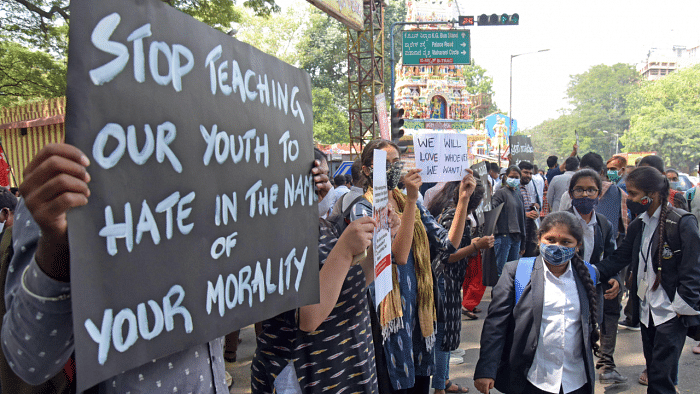
On Easter Sunday, Prime Minister Modi visited the Sacred Heart Cathedral Catholic Church in Delhi, where he lit a candle and planted a sapling on the lawns.
Earlier, on Christmas eve, President Droupadi Murmu visited the same church and, in her message, said the festival was a symbol of peace and brotherhood for the entire mankind. Laudable gestures indeed. If only the two leaders articulated a message of reassurance to Christians during their visits to the church, which has been the site of major protests against atrocities committed against Christians?
Sadly, that was not to be.
Read | India's biggest challenge
And so, the attacks on Christians and churches in India continue unabated despite ongoing protests and petitions, a clear sign of the growing atmosphere of religious intolerance.
Several pleas have been made to the authorities in recent years. To cite two latest instances, 93 former civil servants under the banner of the Constitutional Conduct Group, in a March 4 letter, have urged Prime Minister Modi to end the rising hatred and violence against Christians in the country.
“It is imperative that you, Prime Minister, give them this reassurance,” they insisted in the open letter.
In March, the United Christian Forum (UCF) appealed to the President of India through a memorandum for the protection of the constitutional rights of the Christian community in light of the escalating violence.
Despite this and several peaceful protest marches, attacks, violence, vitriolic hate speeches, and vandalism against Christians continue with frightening regularity.
In the first three months of this year alone, there have been several incidents in various states. During the Christian holy week leading up to Easter, the Madhya Pradesh government had to provide protection to 18 churches in Jhabua district, where Christians face hostilities from Hindu nationalist groups.
There have also been reports of many schools, hostels, and orphanages run by Christians in Madhya Pradesh coming under the scrutiny of the state’s child rights panel under the pretext of curbing religious conversions.
In the Ghaziabad district of Uttar Pradesh, a pastor and his wife were arrested in February following complaints of religious conversion by Bajrang Dal. The couple was freed after 30 days behind bars due to a lack of any solid evidence, reported UCA News, the independent Catholic news service from Asia.
More recently, the district collector of Daman issued a notification regarding the acquisition of land around the 400-year-old heritage Chapel of Our Lady of Augustias for “beautification of the football field”. Anguished by the move, representatives of the church have given a memorandum to the collector and administrator of Daman, highlighting the importance and history of the church. Let alone the attacks, hate speech against Christians and church leaders at public functions and on social media is disquieting.
A video of an event in Gujarat’s Gandhinagar circulated on social media and showed defamatory statements made against the Pope. The speech makes obnoxious references to the Pope and nuns, calling on the crowd not to tolerate Christian priests and nuns in their midst.
In March, the Archbishop of Gandhinagar wrote to the chief minister of Gujarat, urging him to take “immediate and stringent” action against the speaker (who is yet to be identified) and organisers of the event.
Nearer home, Karnataka’s Horticulture Minister, Munirathna, claimed in a March TV interview that Christians are converting people and asked people to kick them out. The minister has been booked by the police for his alleged hate speech against Christians.
It must be said that these organised assaults by vigilante groups are patterned on claims that Hindus are being forcibly converted to Christianity through allurements, claims that have been
denied repeatedly and have yet to be proven.
Christians are accused of forcible conversion, but their total strength is less than 2.4% of India’s 1.3 billion people. The number has remained the same since the 1951 census.
If there is indeed forcible conversion, as alleged by the vigilante groups, it should be challenged and proven in the courts. Thus far, no one has been found guilty of conversions, nor has any conviction taken place.
Church leaders are unanimous that the attacks are a systematic, deliberate, and conscious push to polarise the atmosphere and show minorities their place. Others are of the view that the aim is to intimidate the community by making hate speeches and vandalising churches and educational institutions.
It is only when the authorities at the highest level speak up that the message percolates down the ranks. But unfortunately, the silence of the powers-that-be is deafening. And as long as they don’t unequivocally condemn hate crimes, this ugly trend will persist despite any number of pleas from religious leaders, social activists, or interdenominational organisations.